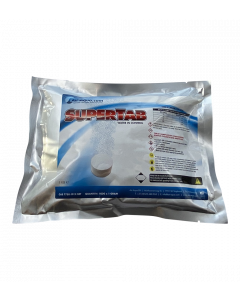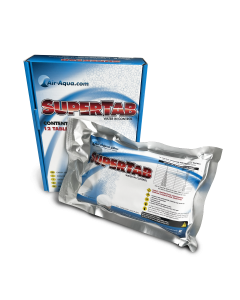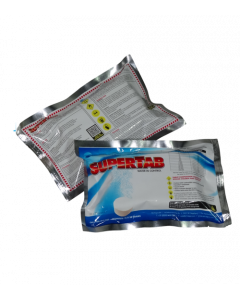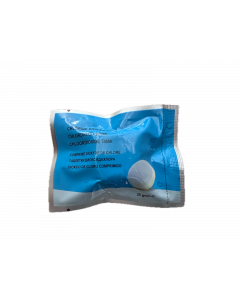SuperTab - Chlorine Dioxide
Get hold on your bacterial load
- reduces anaerobic bacteria, viruses and fungi
- fishing significantly more active
- neutralizes organic waste
- cleans in time system / pipes
- fungi, viruses and bacteria build no resistance
- virtually no effect on plant life
- reduces odor of (swimming) water
- easy to dose
- effective at low concentration
- no harmful by-products
- affordable in use
Calculation SuperTab/ClO2 dosage
SuperTab is the oxidant chlorine dioxide (ClO2) in tablet form. This tablet form of chlorine dioxide is a new development and makes the use of the product very easy. Chlorine dioxide (should not be compared to or confused with chlorine) s a relative weak oxidizing agent. Therefore its allowed to be present in specific concentrations in drinking water and ponds with live stock.
Chlorine dioxide is very effective in killing pathogens such as fungi, bacteria and viruses. Chlorine dioxide is a very selective oxidant and reacts mainly with organic substances. Anaerobic bacteria cannot become resistant to chlorine dioxide because, unlike UV or antibiotics, the cell wall is destroyed.
Contrary to many other oxidants, chlorine dioxide is also very effective at low temperatures and high pH values. Unlike chlorine, chlorine dioxide does not affect the pH value.
Chlorine dioxide is a lot less effective in the dark, which limits the adverse effect on biological filters to a minimum. Also due to the low oxidation power, bacteria, which provide the conversion process of proteins/ammonia/nitrite to nitrate, are hardly affected by low concentrations of ClO2. Because anaerobic bacteria (pathogens) have a very thin skin, they are already killed at very low concentrations.
The major advantage of chlorine dioxide, in comparison with other oxidants (hydrogen peroxide, ozone and chlorine), is its low oxidation power, in combination with a high oxidation capacity.
Low oxidation power:
The more powerful the oxidant, the more dangerous it is for living organisms. Because of its power and potential harmful effects on, for example fish, no free ozone may be present in the water. Therefore, ozone is always used out of reach of the fish, and it is ensured that no residual ozone is present in the water.
Oxygen is a very weak oxidant: as much oxygen as possible should be present in the water to prevent pathogens and to neutralise harmful (reducing) substances.
Chlorine dioxide lies above oxygen, but far below ozone with regard to its oxidation power.
High oxidation capacity:
To neutralise the same amount of dirt 2.5 times the amount of other oxidants is needed compared to chlorine dioxide. In other words, the concentration of chlorine dioxide only needs to be 40% of that of other oxidants to kill anaerobic bacteria or to neutralise organic material.
The combination of low oxidation power and high oxidation capacity makes this product very suitable for relatively safe and easy use in many applications.




